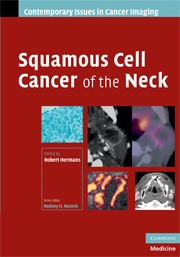Book contents
- Frontmatter
- Contents
- List of contributors
- Series Foreword
- Preface to Squamous Cell Cancer of the Neck
- 1 Introduction: epidemiology, pathology and clinical presentation
- 2 Radiotherapy and chemoradiotherapy of the head and neck
- 3 Surgery of the orocervical region
- 4 Laryngeal and hypopharyngeal cancer
- 5 Oral cavity and oropharyngeal cancer
- 6 Nasopharyngeal cancer
- 7 Neck and distant disease spread
- 8 Post-treatment imaging
- Index
- Plate section
- References
7 - Neck and distant disease spread
Published online by Cambridge University Press: 24 August 2009
- Frontmatter
- Contents
- List of contributors
- Series Foreword
- Preface to Squamous Cell Cancer of the Neck
- 1 Introduction: epidemiology, pathology and clinical presentation
- 2 Radiotherapy and chemoradiotherapy of the head and neck
- 3 Surgery of the orocervical region
- 4 Laryngeal and hypopharyngeal cancer
- 5 Oral cavity and oropharyngeal cancer
- 6 Nasopharyngeal cancer
- 7 Neck and distant disease spread
- 8 Post-treatment imaging
- Index
- Plate section
- References
Summary
Nodal metastases
Background
Cervical nodal metastases have a significant impact on the outcome of patients with squamous cell cancer (SCC) of the head and neck (HNSCC). Nodal metastases are a cause of mortality in patients in whom the primary cancer is controlled, and they increase the risk of distant metastases. Prognosis decreases with increasing nodal stage and overall the rate of cure is halved in those patients with nodal spread. Classification of nodal groups was based originally on anatomical location according to Rouvière and later adapted to surgical levels. These surgical levels have since been translated to radiological levels using anatomical landmarks on axial computed tomography (CT) and are in the process of being adapted to clinical target volumes for image-guided radiotherapy. Both anatomical sites and levels are currently used in clinical practice (Fig. 7.1). Disease within the nodes tends to spread in an orderly fashion down the neck, although skip metastases are found in 5% of patients and routes of spread may be altered by bulky nodal disease and previous treatment. The sites of preferential nodal spread from primary HNSCC are shown inTable 7.1. Staging nodal metastases is performed using the TNM classification set out by the American Joint Committee on Cancer (Table 7.2). For nodal staging purposes, 3 and 6 cm are the important size criteria. Nodal metastases denote advanced stage disease (N1, stage III; N2, stage IV).
- Type
- Chapter
- Information
- Squamous Cell Cancer of the Neck , pp. 114 - 134Publisher: Cambridge University PressPrint publication year: 2008



